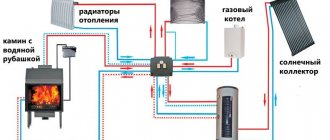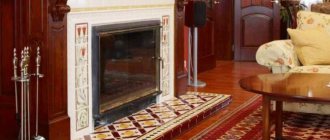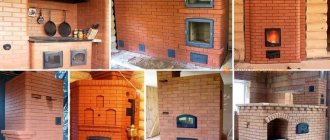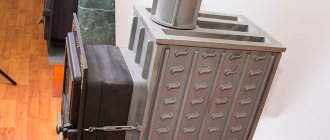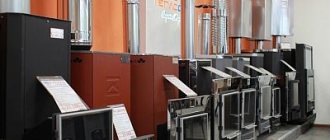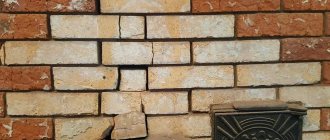One of the ways to heat a house is steam heating from a stove. Although this method came to us from the past, it does not lose its relevance, and recently interest in it has even been growing. The emergence of new building materials with higher technical characteristics gave stove heating a new impetus in development. So why do some homeowners do not pay attention to modern solid fuel boilers with high efficiency values, but prefer a classic water-heated stove made of brick?
Differences in the design of water heaters
The name “Titan” is popularly attached to such devices, although there are several manufacturers of wood-burning speakers.
In principle, titans have a similar design, but there are still a number of differences, based on this we will give a classification:
- in different models the firebox can be either separate or combined with a water tank
;
Note! This division allows the tank to be rotated, which is convenient in cases where it is necessary to make a connection in the bathroom. The tank can simply be turned in the desired direction.
- By the type of tank material, we can mention products made of cast iron, ordinary steel, stainless steel; enameled water heaters have also earned positive reviews. The firebox is made of steel or cast iron;
- in more modern models, a seat for installing a heating element may be provided
. If there is electricity at the dacha, then titanium will be able to work both from burning solid fuel and from the network. When equipping a structure with a heating element, the manufacturer most often equips it with a thermostat, which will allow you to automatically maintain the temperature of the water in the tank;
- Also, most manufacturers take into account the operating features of the products and make it possible to pour water from above. So if , then the tank can be filled with plain water;
- There are also gasified titans
, but this option from the point of view of autonomy is not the best option.
You can recognize which device is in front of you by the markings:
- the designation KVL LF indicates a boiler model with the possibility of using heating elements. Most likely, this model also has a thermostat to maintain a constant temperature;
- KVS - in this titanium model, the firebox and water tank are combined;
- the letters KVL indicate a separate firebox and water tank.
Electric water heater for heating
There are many ways to heat a house using unconventional methods.
However, not all of them are sufficiently effective, although there are those that have confirmed their efficiency in practice. One of the effective options that has been tested many times in real life is the use of an electric water heater for heating. The principle of operation of a water heater in heating
The design, which is non-standard at first glance, is characterized by relative ease of installation, as well as operational efficiency. Although this option is not without its drawbacks, it can be found in many domestic apartments.
- Main characteristics of the device
- What parameters are taken into account when choosing a storage device?
- Indirect heating boiler
- Installation of the boiler into the system
More information about wood-burning water heaters
At first glance, such devices look like relics of the past, but it’s no joke - during the rampant electricity and gasification, it is proposed to use firewood for heating. But wood-burning titanium does not lose popularity, so it’s worth figuring out what the reason for this is
Reasons for popularity
There are several reasons for the popularity of wood-burning water heaters:
- versatility - literally any flammable substance can be used as fuel with the exception of coal. Not only firewood can be used, but also sawdust, shavings, combustible waste from a summer cottage and even paper;
Note! If you nevertheless load coal into the firebox, the metal can quickly burn out - the temperature will be too high.
- economical - literally 5-7 medium-sized logs are enough to heat the water in the tank. Although the water heater is inferior in heating time to its electric counterparts, the process still proceeds quickly;
- ease of installation;
- low cost. The price of a modern water heater is about 15,000 rubles. For this money, the buyer receives a steel tank of 86 liters, a cast-iron firebox with an ash pan, as well as a mixer and a shower head, that is, a complete set, except for a chimney. The full volume of the tank is guaranteed to heat up to 80ᵒC within 45 minutes;
- Some enterprising summer residents use old water heaters as room heaters. Instead of water, sand is poured into the tank and the heater is ready for use; it can easily heat a small house in the country.
There are, of course, some minor drawbacks. For example, during severe use, the tank may leak along the seam; the reason for this lies in the fact that it is not designed to withstand significant pressure. You can also note the small thickness of the metal of the tank - about 3 mm.
Design and principle of operation
Any wood-burning water heater operates on the same principle - fuel is burned in the firebox, and the resulting energy is used to heat the water in the tank. The firebox and tank can be separated (this leads to a slight slowdown in the water heating process) or placed in one cylindrical body.
To ensure that the heat generated during fuel combustion is used as efficiently as possible, a gas exhaust pipe passes through the entire titanium. Due to this, the water heats up faster.
As for the chimney, its diameter exceeds 100 mm (manufacturers often make the outlet hole 115 mm). Due to this, conventional sandwich chimneys can be used. In order not to bother with laying it through the ceiling and roof, you can simply lead the pipe through the wall and lift it to ensure good traction.
Titan shower wood-burning water heaters have another interesting feature - the mixer that comes included has only 1 input - for cold water. But hot water is supplied from the water heater tank.
Note! It is for this reason that it is impossible to replace the complete mixer with a conventional analogue that you like. After all, typical bathroom faucets have 2 inputs.
Features of operation and improvement of titanium
The key feature of a wood-burning country water heater is that it is not designed to withstand significant pressure. The manufacturer assumes that water will be poured into the tank manually, the maximum - the required pressure will be created by a container raised on the roof, or a country water supply, but the pressure in it is low.
Separately, it is worth dwelling on the modernization of the design; a small improvement with your own hands and ordinary titanium can be used, for example, for water. Moreover, this will not lead to significant costs.
The point of modernization is that the mixer is removed from the usual circuit, and water circulation is organized as in conventional electrical devices:
- cold water will enter the tank from the bottom, at the point where the mixer was previously installed;
- In order for the water to be drained without problems, you will need to install an air intake valve near the top fitting. If you try to drain the water without it, then the air simply will not replace the drained water and it will not be possible to drain all of it;
- a safety valve (to relieve excess pressure) is installed optionally. The fact is that if a tank raised to the attic is used as a source of water, then it will play the role of an expansion tank in the heating system and the pressure in the water heater tank will not exceed the norm;
- It can also be recommended to additionally insulate the titanium tank, but this is at the request of the owner.
Installation and connection of titanium
This stage is also performed without the help of specialists. First of all, you should take care of fire safety; after all, titanium heats up quite well, and a coal can always fall out of the firebox.
Several rules must be followed:
- The wood-burning water heater is installed only on a base made of non-combustible material. You can cover a section of the floor with asbestos slabs or build a small foundation of brick or concrete;
- the walls should be thermally insulated; any non-combustible materials, including asbestos boards, are suitable for this.
Connection instructions may look like this:
- there are 2 tanks on the roof of the shower - 1 with cold water, the 2nd with hot water (it can be lined with foam);
- the pump supplies cold water to both tanks from the well; it can also be supplied from the country water supply;
- then water from the insulated tank enters the titanium, heats up in it, and returns to the tank;
- From both tanks, supply pipes are connected to a conventional mixer in the shower; it is also possible to install pipes for other consumers.
Note! Thermal insulation of the tank allows you to maintain sufficient water temperature for at least a day.
Types of chimney devices
Among the air varieties, the traditional model for self-production is a tubular heat exchanger, although there are many other options.
Let's consider the main types that are relevant for installing long-burning stoves, small-sized potbelly stoves, and waste stoves on the chimney. The heat they convert from the energy of combustion products is called dry.
If we schematically imagine the internal part of the devices, it may have the following variations.
Horizontally or vertically located pipes welded to the firebox body. The vertical arrangement is more efficient, as air flows better through the channels. Manufacturing material – steel.
A pipe wrapped around the firebox. For good heat transfer, 2-3 turns are enough, but it is better to move them slightly apart to increase the heating area.
Partitions inside the housing. A kind of labyrinth is made up of metal plates installed vertically. The optimal thickness of parts is from 6 mm to 8 mm.
Pipes passing through the firebox.
With vertically located channels, air movement is more intense, therefore, the productivity of the device is increased. But in some cases, devices with horizontally located pipes or with partitions are appropriate. Each of the listed models is suitable for self-production if you have welding skills.
Design and operating principle
Perhaps to the modern generation a wood-burning heater seems like a curiosity, but our parents remember well what it is. Previously, the wood-burning column was called titanium. Structurally, a wood-burning boiler is a large water tank. Its capacity in a wood-burning column may vary. The capacity varies from 80 and 200 liters. Options for wood-burning heaters with greater productivity can be easily manufactured to order. Under the water tank of the titanium shower is a firebox for wood. This is where the whole process takes place. At the top of the wood boiler there is a shower outlet. Through it, hot water flows into the mixer, which is located below. The presence of pressure is not necessary for the entire process. Water under its own pressure can drain and fill the bathroom from a wood-burning boiler, and cold water can easily be unscrewed from the well.
The best quality is considered to be a wood-burning heater with a stainless steel tank. Such a wood-burning column better resists corrosion and temperature. The firebox of a wood-burning heater can be joint or separate. The difference is that in the second version of the wood boiler, the water tank can rotate around its axis. This means that it will be easier to place such a column in any room, since the firebox can be turned towards the door. Also, such a product is easier to maintain. If the combustion chamber of the boiler needs maintenance, this can easily be done separately. The tank is also easy to repair if it starts to leak.
Advice! Choose a wood-burning stove with a cast-iron firebox. Its walls do not burn out as quickly as sheet material, so it lasts longer. It also retains heat longer.
Which material is better
When constructing a heat exchanger, metal parts are used - galvanized sheets, gas cylinders, pipes of various diameters, cast iron blanks, etc. Cast iron is not recommended because, compared to steel, it is brittle and heavy, which makes it difficult to install on a chimney.
The best option is austenitic steel. Stainless steel easily tolerates thermal changes, is resistant to mechanical damage, and can be independently processed and welded.
Galvanized steel is inferior to alloyed or austenitic steel, since it is not intended to be heated. High-temperature conditions lead to the release of zinc oxides, which are harmful to health, so if you plan to increase the temperature in the chimney to + 419.5 ºС, galvanizing should be abandoned. It is better to purchase expensive but safe material.
Advantages and disadvantages
The main and undeniable advantage of a wood-burning heater is fuel. Not only firewood is suitable, but also anything that can burn without emitting toxic smoke. For example, if you have old tires without a cord lying around your dacha house, you can cut them into pieces and put them to use. Heating of water with them will occur faster, because they burn well and generate enough heat. Another positive point is the ease of integration into the existing water supply system. The shower column is also easy to connect to a storage tank, which can be located on the roof to create pressure.
If there is an electricity supply to the house, then you can additionally install a heating element in the wood-burning water heater, which will heat the water when you are too lazy to carry firewood. True, in the latter, titanium heats up many times faster than an electric boiler with a smaller volume of liquid. The device is completely independent and autonomous, so no interruptions in the network or water can prevent you from enjoying hot water. Another positive point is the relatively low cost of even the “top design”.
Disadvantages include the lack of automation. If you do not take into account models with a heating element and a thermostat, then titanium cannot be left and gone. It will either go out or, conversely, begin to boil if a second stack of firewood has been made. In the cold season, when the device is not planned to be used, the water must be drained. If it freezes and expands inside, this will lead to failure of the entire structure. For some, the disadvantage will also be the need to constantly clean up waste combustion products.
Why a brick oven?
Unlike a variety of solid fuel boilers, brick stoves for water heating create a unique, healthy microclimate in the house. Few would argue with the fact that in a house heated by a stove, a feeling of special comfort and coziness appears. The special smell of wood is pleasant, even the warmth smells somehow special. Heating your home with a wood-burning heat source is, first of all, healthy.
Brick stove with water circuit for heating system
Thanks to the massiveness and heat capacity of the structure, a water-heated stove retains heat for a long time. True, this only applies to rooms bordering the heat source, since when the firebox is extinguished, heating of the coolant stops. Nevertheless, the heated air masses from the walls will maintain heat in other rooms for a long time.
Stone stoves for heating a home are not as expensive to manufacture as one might think. A high-quality solid fuel or pellet boiler can cost no less, or even more, to build a stove. But the durability of these different heat sources is not even worth comparing, despite the fact that the price is presumably the same.
For reference. According to the leading German brand BUDERUS, their solid fuel boilers with a cast iron combustion chamber can last up to 30 years. While a brick oven will function for as long as your house lasts - 50 years or more.
The listed types of stoves are the most common; in fact, there are many varieties of such heat sources, which makes it possible to choose the most suitable one for your home. To do this, it is recommended to consult with an experienced stove maker. As for their shortcomings, the most significant is the need to constantly add firewood or coal, this is inevitable. Even the most spacious firebox burns well for 3-4 hours, no more.
Advice. When making a steel water heater for a furnace, you should not skimp on materials. The ideal option is heat-resistant thick metal, which is not subject to burning and will never cause you problems.
In terms of efficiency, brick heating stoves cannot compete with high-tech boilers; their best indicators barely reach 70%. This is due to the insufficiently efficient extraction of thermal energy from flue gases. But it is stoves with a water circuit that give the best performance, since the metal coil of the heat exchanger effectively lowers the temperature of the combustion products, transferring their heat to the network water.
Possible applications
A wood-burning heater can be used in the most unusual and interesting ways. The most obvious application is in the bathroom or outdoor shower. If in the summer you like to install an inflatable pool at your dacha or have a self-made structure, then such a wood-burning boiler can be used as a heater. To do this, you just need to bring a hose to the entry point, connect the pump to it, and throw the other end into the pool. Light the titanium and turn on the circuit and add firewood. The water from the pool will flow into the boiler, warm up and return back. In a short time it will be possible to warm up a large amount of water.
Thanks to the firebox in a wood boiler, energy is transferred not only to the water, but also to the environment. This means that with the right layout and choice of location, it is possible to organize heating of additional rooms. For example, a wood-burning boiler can be mounted into the wall so that the firebox opens into one room, and the shower is located directly in the bathroom. Due to the fact that the firewood will be stored in one room, it will also be warm due to the firebox and the heated tank.
Connecting an instantaneous water heater
In a flow-type boiler, water passes through its shell, and the heating element turns on only when the water flow moves in the body of the device. Therefore, overheating in this system is practically impossible and a pressure release valve is not installed in the heater.
A shut-off ball valve and necessarily coarse sand filters are placed in the cold water supply pipeline of a flow-through water heater - the absence of filter elements is a gross violation of the operating rules and may cause the service organization to refuse to fulfill its warranty obligations.
Rice. 9 Examples of installation of instantaneous water heaters
Installation process
If you are thinking about buying a wood boiler, it is good to know how to install it correctly once it has been delivered. To do this, it is necessary to determine the purposes of its use, as described above. Tools for installing a wood boiler you will need:
- gas or adjustable wrench;
- level;
- perforator;
- roulette;
- fastening consumables;
- Bulgarian;
- metal fittings;
- marking tool.
The first step before installing a wood boiler is to prepare a place for it. With a boiler tank capacity of 200 liters, the total weight with a fully filled flask can exceed 300 kg. This means that the base for the wood boiler must be strong enough. Also, the wood boiler should not be tilted, as if it falls, it can cause serious injury or death. In the room where the wood boiler will be installed, a square area with a minimum size of 1 m 2 is marked. Using a grinder, the contour is determined and a 15-20 cm deepening is made. A concrete solution is prepared from cement.
Stands made of brick or stone are placed inside the prepared recess to a height of 5 cm. The rods are evenly laid out on them. They can be twisted with tying wire to form a lattice. The concrete mixture is poured on top and compacted well. To ensure that it fills all the cavities, you can pierce it with a piece of reinforcement so that air bubbles rise to the surface. Using a spatula, the surface is leveled and usually brought to a horizontal level. The site for the wood boiler will gain full strength within two weeks.
Note! Such surface preparation will be needed if the floor in the room is leaky or if you plan to install a wood-burning heater with a large tank volume.
A sheet of galvanized metal or thick foil is mounted on the walls around the wood column. They will serve as reflectors that will prevent surfaces from overheating. The wood-burning column is placed in its place and secured to the prepared base using bolts and dowels. A chimney outlet is drawn. If there is a stove channel nearby, then you can take it directly there. But at the same time, everything needs to be calculated well so that there is no backdraft. The water supply is made, the mixer and the shower tube are fixed in place. Make sure that all threaded connections are tightly wound with tow. This is important so that boiling water from the wood boiler does not leak out.
Traditional heating systems
In search of a universal solution, craftsmen tried many options and each of them is good in its own way.
It cannot be clearly said that there is a universal option, so the choice should be made depending on the conditions existing at a particular site.
- In the process of building a bathhouse, many modern owners prefer to take the easiest route and purchase an electric boiler. The option is undoubtedly worthy, but it requires a constant supply of water, plus for a large capacity the energy costs will be sensitive.
- A water heating tank built into the stove is considered a classic. Such containers heat up quickly, the installation instructions for such heaters are the simplest; in the most affordable option, it is enough to place the tank on the stove. But it will be located low and, being in the steam room, will become a source of wet steam, which is not always good.
- Remote tanks have proven themselves well when the main tank is mounted at a comfortable height in a dressing room or shower, and heating is carried out through a heat exchanger installed in the firebox. They work thanks to the elementary laws of physics: cold water enters the heat exchanger through the lower pipe and, when heated, returns back through the upper conduit.
- But the most profitable and convenient to use are those containers mounted directly on the chimney; we will talk about them further.
Do-it-yourself wood-burning heater
The design of a wood-burning heater is quite simple, so you can make it yourself at home. This will require skills in working with a welding machine, as well as other power tools. You will need the following materials and tools to make a wood-burning stove:
- Bulgarian;
- roulette;
- welding machine;
- marking tool;
- metal pipe ½";
- metal couplings with ½" internal thread;
- grate;
- a ready-made tank or two gas cylinders;
- chimney pipe;
- Sheet steel.
The first step in making a wood-burning boiler is making the tank. You need to take two gas cylinders, unscrew the locking mechanisms and let them stand for several days in the fresh air. Using a grinder, the bottom of one and the other product is cut off. This results in two forecastle tanks for the future wood-burning boiler. Now a hole is made at the end in the middle of each element through which the chimney pipe in the future wood-burning boiler will pass. Two parts of the cylinders are welded together to form a tank. A piece of pipe is placed inside so that it protrudes slightly from above. The seams are well welded using a welding machine.
A hole with a diameter of 15 mm is drilled in the upper part of the cylinder for a wood boiler. A coupling with a ½" internal thread is welded onto it. This will be the outlet for the shower pipe. Another hole is made just below the middle of the cylinder. A tee is mounted to it, through which cold water will be supplied, and a mixer for the wood-burning boiler will also be attached there. The shower pipe is fixed into a coupling fixed at the top and part of it is lowered to the mixer so that it also contains hot water.
The firebox for a wood boiler is made from sheet metal. It can be made square. Height is approximately 50 cm. The bottom of the firebox for the wood-burning column is covered with a sheet of metal. The grate bars are fixed at a height of 20 cm from it. A round hole is made in the upper part of the firebox, which will serve as a mounting hole for the prepared tank. Legs made of reinforcement are attached to the bottom of the firebox for the wood column. A tank is placed on top and boiled around the perimeter. The next step is to secure the doors and install them in place.
This version of the wood-burning column design is provided as a basis. You can vary the materials, the main thing is that the basic principle of assembly is clear. Below you can watch a video of another boiler option. Having a wood-burning heater in your dacha is an excellent solution that will help out in any circumstances and will allow you not only to always be clean, but also not to freeze on cold nights.
Possible improvement methods
Despite the simplicity of the principle of operation, such a water heater is very convenient to use, but requires a number of modifications. First of all, at the outlet of the chimney from the tank, you need to drill a through hole and insert a pin with a damper disk into it. At the same time, the disk does not have a rigid attachment to the stud, because the damper must be periodically disassembled to clean the chimney.
To service and repair the heater, it will need to be disconnected from the piping, so it is recommended to install “American” type connections made of brass on the threaded pipes of the tank. The lower pipe is connected directly to the water supply system through a shut-off valve. Also in this place you can make a drain outlet with a tap and a fitting for connecting a flexible hose. On the upper branch pipe it is necessary to provide a free outlet with a ball valve to allow air to leak in when draining water from the tank. A standard safety group is installed behind the outlet - an excess pressure relief valve for water heaters. Next, a shut-off valve is packed behind the group.
If the water heater is located outdoors, it will not be superfluous to provide thermal insulation to the tank. It is quite easy to do with ordinary basalt wool. You will need a wide piece of steel reinforcing mesh, rolled into a ring to form a gap from the tank walls of about 50–70 mm. The insulation is attached to the mesh with thin wire, then the resulting casing is wrapped around the water heater and tightened with wire clamps.
Hot water boilers
Water-heating double-circuit wood-burning boiler
In addition to just water heating devices, in many cases a home also requires a heating boiler, which can be installed in combination with titanium or purchased a boiler with a built-in boiler.
This diagram clearly shows how one boiler can perform two functions and provide a house with heat and heated water.
Boiler design and operation diagram
Boiler design
In this case, the diagram clearly shows the boiler built into the boiler body. This heating device has a labyrinth system for the passage of heated air - this is a firebox where fuel and three horizontal plates are placed, between which hot gases pass. By staying longer in the boiler, they give off heat more significantly and, before going out into the chimney, they manage to warm the water for heating and the boiler for using the heated water for domestic purposes.
The boiler runs on wood, but there are models that run on gas, pellets or diesel fuel. The last option requires a little modernization: a burner is installed in the bottom door. A device operating on wood can be converted to use another fuel even after its installation, but for this you should invite a specialist. The diagram clearly shows changes in the design after reworking the boiler.
The efficiency of a boiler arranged in this way reaches 87-92%. In addition to the design itself, the fairly thick walls of the combustion chamber also contribute to high heat transfer - their thickness is half a centimeter. Such models are equipped with pump activation thermostats, a cooling circuit and a thermometer.
Cleaning the boiler and maintaining it during its operation is extremely simple; an accessory for cleaning it is usually included with the device.
Installing a boiler is no different from installing titanium - this must be done while observing safety precautions. The size of the chimney pipe will depend on the boiler model - its diameter can be determined by the pipe coming out of the boiler. The chimney is discharged through the roof and waterproofing must be installed around the head. The head should rise above the roof according to the same principle as discussed above.
The easiest way
Manufacturers make sauna stoves with ready-made water tanks. This option is the simplest for installation and further operation. Relevant for buildings that do not have gas and water supply communications; a limit on the use of electricity has been determined.
Hot water tanks can be installed in two ways:
- The tank is placed directly on the chimney pipe of the stove, the liquid is heated by the heat of the smoke coming out. At the same time, the pipe can heat up to very high temperatures (500⁰ C), quickly warming up the contents of the tank. The bottom of the container is equipped with an opening equal to the cross-section of the chimney pipe. It is necessary to ensure the tightness of the joints of the pipe and the tank at the inlet so that water does not leak out. The joint can be treated with a heat-resistant sealant, clay-lime-sand mortar. Cement mortar becomes cracked when exposed to heat. At the same time, such placement allows you to heat the water with heat, which is usually removed outside. And it is easier to install a chimney pipe inside the attic space, since excess heat is transferred to water.
- Mounted tank. It is placed wall-mounted on one side of the stove, most often inside the steam room (capacity 40-70 l). A wood stove heats the water in the tank in 1.2-1.6 hours. To speed up the process, you can thermally insulate the tank. It is also a simple, low-cost method that does not require significant material costs and is easy to maintain.
Placing such a tank inside the steam room is considered a disadvantage due to the large release of water vapor. For bathhouses located in the country, this is one of the few available ways to heat water that does not require any effort in winter arrangement. A current option for a classic Russian bath. It is not recommended to equip a sauna with such a tank.
How to make a solar water heater for your home with your own hands? >>>>>>
Criterias of choice
All models differ in materials of manufacture, build quality, and technical characteristics. To select the right heater, you need to familiarize yourself with several points:
- a hot water column with a built-in firebox heats up 10-15% faster;
- if the firebox is separate, then the water container can be rotated and it is possible to install the watering can in a convenient position;
- a cast iron firebox will last longer;
- a stainless steel water container is considered more reliable and durable;
- some models may have an electric heating device (TEH) to maintain the temperature.
Units made in Russia, Czech and Bulgaria are popular among consumers. Unpleasant consequences can be avoided if you know a few simple differences between a factory assembly and a fake:
- It is necessary to pay attention to welding seams. If they are uneven, carelessly cleaned and do not inspire confidence, then it is better to refuse the purchase.
- All accessories (handles, removable panels, covers) should fit tightly into the puzzles and be easily accessible.
- Check the availability of all necessary documents: technical passport, assembly and operating instructions, warranty card with stamp and signature.
For each model, information about the water tank capacity is provided. When choosing and purchasing a unit, you need to pay attention to these indicators. If the family is small, then there is no need to buy a 200 liter dispenser.
